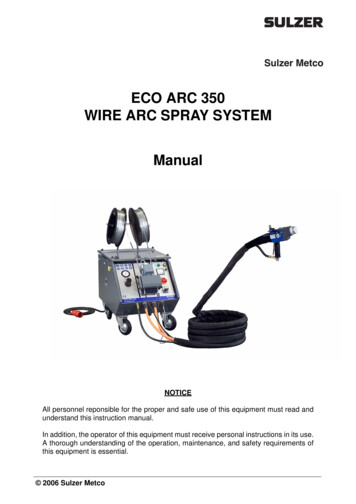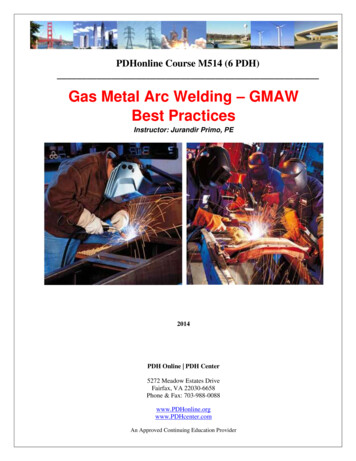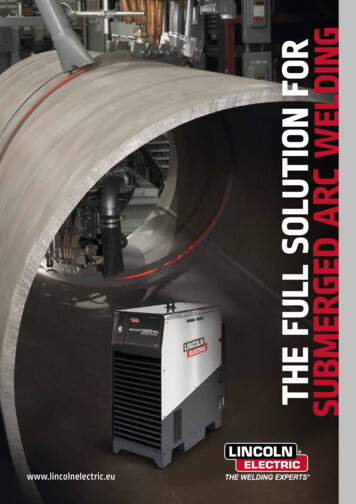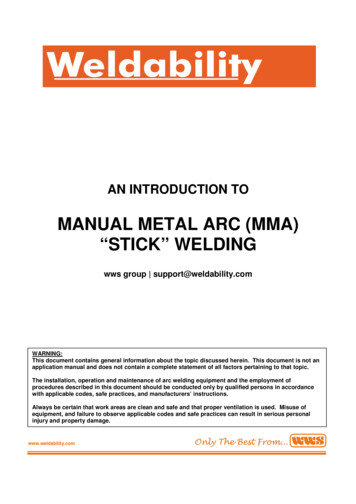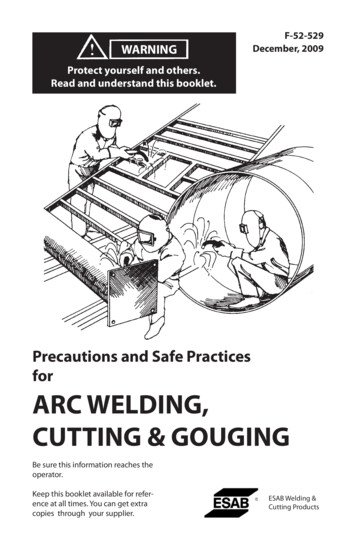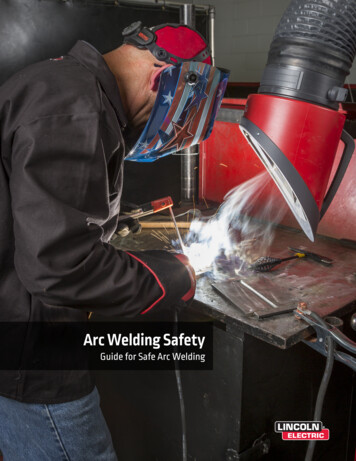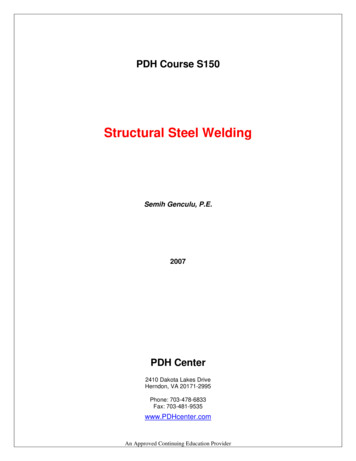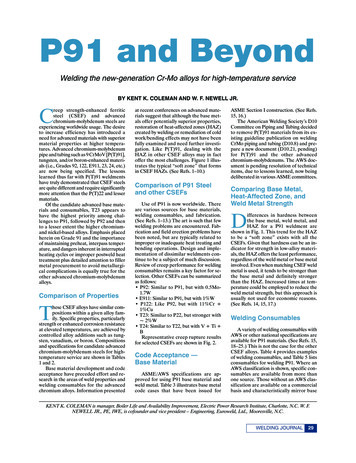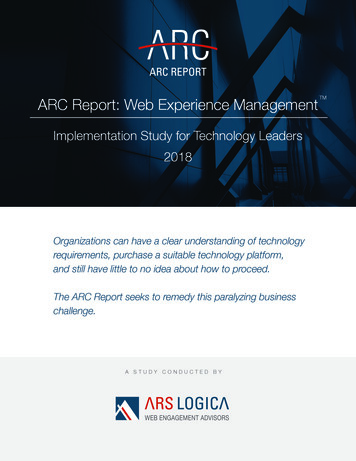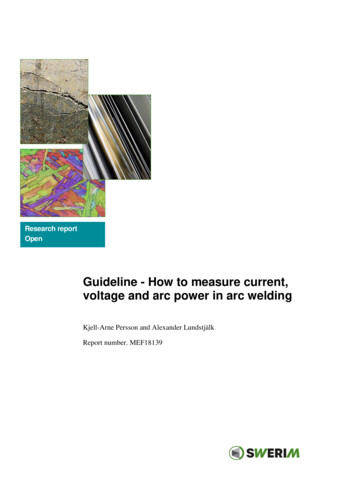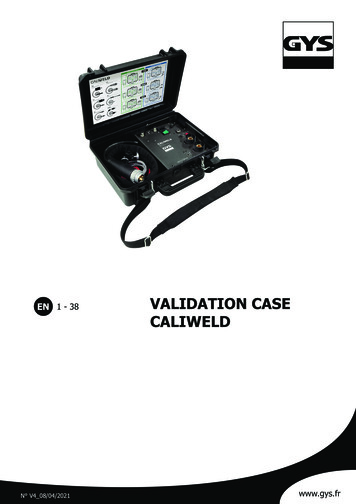
Transcription
EN 1 - 38N V4 08/04/2021VALIDATION CASECALIWELDwww.gys.fr
TABLE OF CONTENTSS Y M B O L S .p 3S A F E T Y I N S T RU C T IO N S .p 4-5S TA N DA R D R E M I N D E R .p 6T E C H N IC A L S P E C I F IC AT IO N S .p 7AC C E S S O R I E S A N D C O N N E C T IO N S D E S C R I P T IO N .p 8S E T U P.p 9S O F T WA R E O P E R AT IO N .p 10-11MENU BAR DETAIL.p 10STATUS BAR DETAIL .p 11M U LT I M E T E R M O D E .p 12-14DESCRIPTION.p 12START.p 12RECORDING.p 13HISTORY, SAVING & PRINTING.p 14O S C I L L O S C O P E M O D E .p 15-17DESCRIPTION.p 15ZOOM.p 15RECORDING.p 16SAVING & PRINTING.p 17VA L I DAT IO N M O D E .p 18-24DESCRIPTION.p 18IN THE CASE OF AN EXISTING SCENARIO.p 18IN THE CASE OF A SCENARIO CREATION. .p 19START.p 20HISTORY.p 21RECORDING.p 22A P P E N DIC E S .p 26-38
CALIBRATION CASE CALIWELDENSYMBOLSWarning ! Read the instructions manual before use.WARNING. DANGER.WARNING. DANGEROUS VOLTAGE.Risk of electrocution.Complies with European Union directives.EAEC Conformity marking (Eurasian Economic Community).Material complies with British requirements.Material complies with Moroccan standards.85-265 V 50/60Hz15 VA maxSingle phase power supply 50 or 60 HzVVoltage measuring pointACurrent measuring pointnWire speed measuring pointGas input measuring pointGas output measuring pointTaking back remote controlInput point of the measurement flowOutput point of the measurement flowCase power indicatorUSB connections indicatorUSB connectorUSB 2.0Earth clampHF PROTECTIONIP 30Electronics protected against HF of TIG machinesOpen carry case : the product is protected against external objects larger than 2.5 mm. However, it is notwaterproof.3
CALIBRATION CASE CALIWELDIP 67ENClosed carry case : the product is dust proof and water proof for 30 min up to 1 m deep.SAFETY INSTRUCTIONSOnly use this device for its intended use, otherwise the warranty may be void.Inspect the case before using the device: Look for potential defects or cracks. Check carefully the insulation of the terminals.Do not use the product in the vicinity of explosive gases, fumes or in a wet/humid environment.Do not work on your own.The use of this device is limited to the indicated measurement categories, voltage and intensity.Be aware of local and national safety requirements, and make sure to comply. Use personal protective equipment (rubber gloves, mask and heat proof clothing) in order to prevent injuries from electrocution and explosions caused by electrical arcs whendangerous live conductors are exposed.Use measuring categories (CATII), accessories with the right voltage and intensity (sensors, measuring leads and adaptors)suitable for the device for all measurements.Avoid contact with voltage higher than 30 V AC, 42 V AC peak or 60 V DC.Only use the current sensors, measuring leads and adaptors supplied with the machine.Turn the product off if it is damaged.Do not use the device if it is damaged.Do not use the device if it is not working properly.Only use the sensors, measuring leads and accessories which match the measurement category, voltage and intensity of thedevice.Only use cables whose voltage is suitable for the device.Never apply a voltage exceeding the nominal value between the terminals, or between a terminal and the earth.Measure a known voltage (prior to the test) to make sure that the device is working correctly.Use the terminals, the mode and the range matching the measures you wish to take.Do not use damaged measuring leads. Check for insulation defects, exposed metal parts and wear indicator on measuring leads.Check the continuity of the measuring leads by testing a known voltage.Do not create contact between the sensors and a voltage source when the measuring leads are connected to the current terminals.This product should be disposed of in an appropriate recycling facility. Do not throw away in a household bin.This product should be recycled appropriately.4
CALIBRATION CASE CALIWELDENWELDING FUMES AND GASESThe fumes, gases and dust created when welding are a health hazard. It is required to ensure adequate ventilationor extraction for fumes and gases. Using an air fed welding helmet is recommended in case of insufficientventilation in the workplace.Check that the extraction is effective by checking it against recommended safety standards.Caution, welding in small spaces requires surveillance from a safe distance. In addition, the welding of certain materials containinglead, cadmium, zinc, mercury or beryllium may be particularly harmful.Do not weld in areas where grease or paint are stored.GAS CYLINDERSGas leaking from the cylinders can lead to suffocation if present in high concentrations around the work area.Transport must be done safely: cylinders closed and device switched off. They must be stored vertically and heldby a support to limit the risk of falling.The same recommendations apply for the storage of the cylinders. They must also be stored in open and ventilatedareas.Gas cylinders must be stored in an open or ventilated area. The cylinders must be in a vertical position and fastened to a supportor trolley.Close the cylinder in between using it. Be wary of temperature variations and sun exposure.The cylinder must not be in contact with a flame, electric arc, torch, earth clamp or all other sources of heat.Always keep gas cylinders away from electrical circuits and therefore never weld a pressurised cylinder.Be careful when opening the valve of a cylinder, it is necessary to remove the valve head and to make sure that the correct gas mixis used.ELECTRICAL SAFETYThe electrical mains used must have an earth terminal. Follow the fuse rating recommended in the table.An electrical shock can directly or indirectly cause serious and potentially deadly accidents.Do not make physical contact with live parts inside or outside the machine when it is powered such as the torch, earth clamp,electrodes and cables, as they are part of the welding circuit.Before opening the device, it is imperative to disconnect it from the mains and to wait for 2 minutes in order for the capacitors torelease the energy.Do not touch the torch or electrode holder and the earth clamp at the same time.Make sure to replace the torches and cables if they are damaged. This should be done by a qualified and authorised technician.The dimensioning of the accessories should be sufficient.Always wear dry clothes which are in good condition in order to be insulated from the electrical circuit. Wear insulating shoes,regardless of the environment in which you work in.5
CALIBRATION CASE CALIWELDENNORMATIVE REMINDERAccording to the EN1090 standard, a welding generator must undergo a control of its welding parameters. This check allows us to issue a «Validation report».The following validation procedure is based on the reference standards EN 50504 and EN 60974-14.The objective of this procedure is to ensure a correct welding result that is reproducible over time.Validation of welding equipment according to the standard is an action to verify the performance of the product in relation to its settings.Validation is carried out on 5 measuring points within the adjustment range. It is nevertheless possible to validate a reduced adjustment range atthe customer’s request.Select the validation/calibration range of the control or indicator assembled on the power supply as follows:a) the complete range of the control or measuring device (see note);b) a partial range of the control or measuring device;c) the selected points within the range of the control or measuring device.NOTE The maximum values of the range for voltmeters and ammeters are given by the no-load voltage and the maximum welding current of thecurrent source.Before performing the validation/calibration, it is necessary to agree with the manufacturer, customer or user on options b) or c).Perform measurements at the minimum setting, maximum setting and at three other points which are at nominally equal distance betweenminimum and maximum over full rangeIn the case of EN 50504, the measurement is carried out twice (rising «a» measurement and falling «b» measurement) after a stabilisation time of10 seconds for the measured values.For En 60974-14, the measurement is performed 3 times (measurement «a», «b» and «c») at short intervals after a stabilisation time of 10 seconds.It is recommended to leave the product in operation for 5 minutes before carrying out the validation procedure.The validation must be carried out at least every year and after each repair or modification that may affect the settings.Only a qualified person can perform these measurements. This person ensures that the test conditions are optimal and the results accurate. Wehighly advise to go through the text of the standard before performing a validation.For specific processes such as Pulsed MIG and TIG AC, user errors and the use of indapated measuring tools may result in measurement errors.The manufacturer of the welding machine must be consulted.Welding machine precisionThe precision of the settings and/or displays is determined by a category, itself determined according to the welding specifications (PQR/WPS) andthe welding machine specifications.Validation type:- For EN 50504, the type of validation can be «consistency» or «accuracy».- For EN 60974-14, the validation type can be «validation», «calibration» or «consistency».This category is split in 2 types: «Standard» or «Precision». It determines the tolerance for the welding settings, the measurements taken and displayed on the machine as well as the measuring tools that should be used.6
CALIBRATION CASE CALIWELDENTECHNICAL FEATURESThe CALIWELD case is a device which allows:- to issue a validation report (certificate which attests the proper functioning of the product - Validation mode).- to check the welding values (current / voltage or energy, wire speed and gas - Multimeter mode and Oscilloscope).Power supply voltage: 85 V to 265 V ( 10%)Frequency : 50 to 60 Hz ( 3Hz)Power : 30 VASupply cable : plug connection IEC 60320-C13Interface : Norme USB-2Remote control : 120 V maxMeasurement characteristics : Voltage: from -120 V to 120 V AC/DC - 0.5% of precision (instantaneous, average or TRMS) Current: from -500 A to 500 A AC/DC - 0.5% of precision (instantaneous, average or TRMS) Gas flow: from 1 l/min to 30 l/min - 5% of precision Wire speed: from 1 m/min to 30 m/min - 1% of precision External temperature: from 0 to 50 C ( 2K)Temperature: Operation: from 5 C to 40 C Calibration (temperature): from 20 C to 25 C Storage: from -20 C to 60 C Preheating: 30 min to take into account the temperature of the roomRelative humidity (without condensation): Operation: from 5 C to 40 C 80% Storage: from 0 C to 60 C 80%Altitude: Operation: 2000 meters Storage: 12 000 meters7
CALIBRATION CASE CALIWELDENDESCRIPTION OF ACCESSOIRES AND CONNECTIONSPictureName - DescriptionRef: 060531 - Measuring cable 2 m CALIWELD VM1- Texas connecti
the welding machine specifications. Validation type: - For EN 50504, the type of validation can be «consistency» or «accuracy». - For EN 60974-14, the validation type can be «validation», «calibration» or «consistency». This category is split in 2 types: «Standard» or «Precision». It determines the tolerance for the welding settings, the measure-

